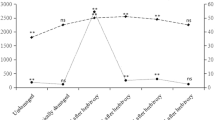Abstract
When introduced into a wind tunnel with low windspeeds (0.2–0.3 m/sec), neonate E. postvittana larvae were more likely to walk in a downwind rather than upwind direction. This tendency to walk downwind did not change when odors from apple leaves or fruit were introduced into the wind tunnel. In a second assay that measured travel times of larvae as they walked from the center to the edge of filter paper disks, larvae moved more slowly on disks treated with extracts of apple leaves or extracts of apple fruit, but did not slow their movement on disks treated with extracts of a nonhost, Coprosma repens. Analysis of videorecords revealed that larvae on disks treated with a dichloromethane extract of apple leaves took more circuitous routes, walked more slowly, and stopped more frequently than larvae walking on solvent-treated disks. When the dosage of this dichloromethane apple leaf extract was increased or when larvae were held without food prior to testing, differences between travel times on solvent- and extract-treated disks did not increase significantly. The dichloromethane apple leaf extract, when tested in the wind tunnel with low windspeeds, also caused larvae to delay spinning down on a silken thread after reaching the edge of the disk, but had no effect on spin-down times when tested in still-air conditions. Testing of rotary evaporated apple leaf extracts and fractionation of these extracts indicated that a number of both volatile and relatively involatile chemicals contribute to the behavioral responses of E. postvittana larvae.
Similar content being viewed by others
REFERENCES
Bell, W. J. 1991. Searching Behaviour, The Behavioural Ecology of Finding Resources. Chapman and Hall, London.
Bernays, E. A., and Chapman, R. F. 1994. Host-Plant Selection by Phytophagous Insects. Chapman and Hall, New York.
Chapman, R. F. 1995. Chemosensory regulation of feeding, pp. 101-136, in R. F. Chapman and G. de Boer (eds.). Regulatory Mechanisms in Insect Feeding. Chapman and Hall, New York.
Danthanarayana, W. 1975. The bionomics, distribution and host range of the lightbrown apple moth, Epiphyas postvittana (Walk.) (Tortricidae). Aust. J. Zool. 23:419-437.
Dugdale, J. S., and Crosby, T. 1995. BUGS database of leafrollers and their host plants. Landcare Research, Mt Albert Research Centre, Auckland, New Zealand.
Eigenbrode, S. D., and Espelie, K. E. 1995. Effects of plant epicuticular lipids on insect herbivores. Annu. Rev. Entomol. 40:171-194.
Eigenbrode, S. D., Espelie, K. E., and Shelton, A. M. 1991. Behavior of neonate diamondback moth larvae [Plutella xylostella (L.)] on leaves and on extracted leaf waxes of resistant and susceptible cabbages. J. Chem. Ecol. 17:1691-1704.
Foster, S. P., and Howard, A. J. 1999. Female and neonate larval preferences towards various plants in the generalist herbivore. Epiphyas postvittana. Entomol. Exp. Appl. (in press).
Galanihe, L. D., and Harris, M. O. 1997. Plant volatiles mediate host-finding behavior of the apple leafcurling midge. J. Chem. Ecol. 23:2639-2655.
Geier, P. W., and Briese, D. T. 1980. The lightbrown apple moth, Epiphyas postvittana (Walker): 4. Studies on population dynamics and injuriousness to apples in the Australian Capital Territory. Aust. J. Ecol. 5:63-93.
Grimes, L. R., and Neunzig, H. H. 1986a. Morphological survey of the maxillae in last-stage larvae of the suborder Ditrysia (Lepidoptera): palpi. Ann. Entomol. Soc. Am. 79:491-509.
Grimes, L. R., and Neunzig, H. H. 1986b. Morphological survey of the maxillae in last-stage larvae of the suborder Ditrysia (Lepidoptera): mesal lobes (laciniogaleae). Ann. Entomol. Soc. Am. 79:510-526.
Harris, M. O., Foster, S. P., Bittar, T., Ekanayake, K., Loou, K., and Howard, A. 1995. Visual behaviour of neonate larvae of the lightbrown apple moth. Entomol. Exp. Appl. 77:323-334.
Harris, M. O., Mafile'o, F., and Dhana, S. 1997. Behavioral responses of lightbrown apple moth neonate larvae on diets containing Bacillus thuringiensis formulations or endotoxins. Entomol. Exp. Appl. 84:207-219.
SAS Institute. 1995. JMP Version 3.1 User's Guide. SAS Institute Inc., Cary, North Carolina, 239 pp.
Schoonoven, L. M., van Loon, J. J. A., and Jermy, T. 1998. Insect-Plant Biology: From Physiology to Evolution. Stanley Thornes, Cheltenham, UK.
Singh, P. 1974. A chemically defined medium for rearing Epiphyas postvittana (Lepidoptera: Tortricidae). N.Z. J. Zool. 1:241-243.
Sinoir, Y. 1969. Le role de palpes et du labre dans le comportement de prise de nourriture chez la larve due criquet migrateur. Ann. Nutr. Aliment. 23:167-194.
Sokal, R. R., and Rohlf, F. J. 1981. Biometry. W.H. Freeman and Company, New York, 859 pp.
Suckling, D. M., and Ioratti, C. 1996. Behavioral responses of leafroller larvae to apple leaves and fruit. Entomol. Exp. Appl. 81:97-103.
Visser, J. H. 1986. Host odor perception in phytophagous insects. Annu. Rev. Entomol. 31:121-144.
Wearing, C. H., Thomas, W. P., Dugdale, J. S., and Danthanarayana, W. 1991. Tortricid pests of pome and stone fruits, Australian and New Zealand species, pp. 453-472, in: L. P. S. van der Geest and H. H. Evenhuis (eds.). Tortricid Pests: Their Biology, Natural Enemies and Control. World Crop Pests Series, Vol. 5. Elsevier Science Publishers, Amsterdam.
Williams, L. H. 1954. The feeding habits and food preferences of Acrididae and the factors which determine them. Trans. R. Entomol. Soc. London 105:423-454.
Author information
Authors and Affiliations
Rights and permissions
About this article
Cite this article
Harris, M.O., Sandanayake, M. & Foster, S.P. Chemical Stimuli from Apple Influence the Behavior of Neonate Caterpillars of the Generalist Herbivore, Epiphyas postvittana . J Chem Ecol 25, 1717–1738 (1999). https://doi.org/10.1023/A:1020917429497
Issue Date:
DOI: https://doi.org/10.1023/A:1020917429497




